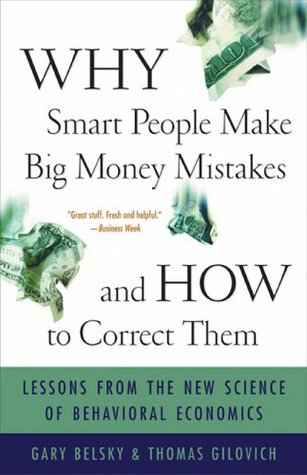Kindle Notes & Highlights
by
Gary Belsky
Read between
February 18 - March 10, 2021
Such guidelines might be instinctive (a long line at a restaurant probably means business is good) or societally reinforced (it’s a good idea to stretch your budget when buying a house), but in either case, they are sometimes misleading.
home prices don’t rise as fast or as much as Americans think, and even when they do, such levels are rarely sustainable (as we have seen in recent years). So there is often no financial justification for buying more house than you can afford in the hope that price hikes will reward you later.
And that is why, when attempting to balance and evaluate their investment port-folio, people often err by failing to knock down mental walls among accounts. As a result, their true portfolio mix—the combination of stocks, bonds, real estate, insurance policies, mutual funds, and the like—is often not what they think, and their investment performance often suffers.
Even if your own answer to these questions is no, it’s a fact that individuals tend to sell winning investments too quickly and keep losing ones too long. It was verified in 1997 by two researchers, Terrance Odean and Brad Barber. They analyzed the trading records of ten thousand accounts at a large national discount brokerage firm over a seven-year period beginning in 1987 and ending in 1993. Among other findings, their gargantuan research effort highlighted a pair of remarkable facts. First, investors were in fact more likely to sell stocks that had risen in price rather than those that had
...more
you tend to sell winning investments more readily than losing ones. • you’re seriously tempted to take money out of the stock market when prices fall.
Throughout this book we’ll gradually build an argument that many individuals should consider an automatic approach to investing by relying primarily on mutual funds—specifically index mutual funds, which try to do nothing more than mimic the performance of the stock and bond markets in general.
Our advice? Put no more than 10 percent of your nest egg into stocks of individual corporations. The rest should be spread out over other kinds of investments.
So ask yourself: “If the stock market drops 25 percent tomorrow, would I be tempted to pull all or some of my money out?” If the answer is yes, you’re probably unprepared for the ups and downs of the stock market.
That’s why any money you’ll need within the next five years should be removed from stocks and put into cash or cash equivalents like government bonds.
For diversification to work as a salve for the pains of loss, you must avoid looking at losses or gains in isolation.
That’s why it’s often helpful to invest in a spreadsheet computer program such as Excel, a software package like Quicken, or any number of Internet sites, that can display and total all your investments.
The goal is not to justify your decision to buy the investment at whatever price you originally paid for it.
The sting of losing money, for example, often leads investors to pull out of the stock market unwisely when prices dip.
How many tales have you heard—or lived through—in which Jane and John Homebuyer couldn’t pull the trigger on their dream house only to see the price go up when another bidder entered the game? Of greater concern, though, is the conflict sparked by the glut of investment options available today.
People tend to overvalue what belongs to them relative to the value they would place on the same possession or circumstance if it belonged to someone else.
In essence, the endowment effect is really just another manifestation of loss aversion: People place too much emphasis on their out-of-pocket expenses (what they have to pay now) and too little value on opportunity costs (what they miss by not taking an action).
you tend to beat yourself up when your decisions turn out poorly.
This was notably demonstrated by Daniel Kahneman and David Schkade in 1998, in a paper that might have been called “The Grass Is Always Greener in California Even Though It’s Not.” (In reality, it was titled “Does Living in California Make People Happier? A Focusing Illusion in Judgments of Life Satisfaction.”)
you spend money in impulsive bursts.
you tend to buy extended warranties or extra insurance policies, just to be safe.
you feel extraordinarily anxious when stock prices fall, even if you don’t need your invested money for years to come.
Our point here is simple: Sometimes knowledge isn’t enough to overcome our visceral or emotional thinking. Sometimes you need a system, a default plan for helping you navigate the push-pull of your brain. Here are some ideas that we’ve found to be helpful over the years—some more so than others, of course, depending on your issues and approach to making decisions.
Gary has another Post-it note on his computer, which reads “Do it tomorrow.”
If nothing else, our maxim that any funds needed within five years should be taken out of the stock market doubtless saved many people considerable anxiety and money.
One of the central tenets of prospect theory—a bedrock principle of behavioral economics—is that people are “loss averse.”
After all, the best way to stop snacking at night is to stop keeping snacks in your house.
Retirees also should invest in stocks with money that they’ll need ten years or more down the road, while money they will need for current living expenses should be invested in safer securities such as money market instruments or short-term bonds.
Trying to extract every last dime out of your financial decisions is likely to incur significant social and psychic costs. As you’ve no doubt noticed, not everyone likes a person who’s obsessed with money. And even if everyone did, an insistence on always making the best financial decision in a given situation can lead to excessive worry and anxiety.


